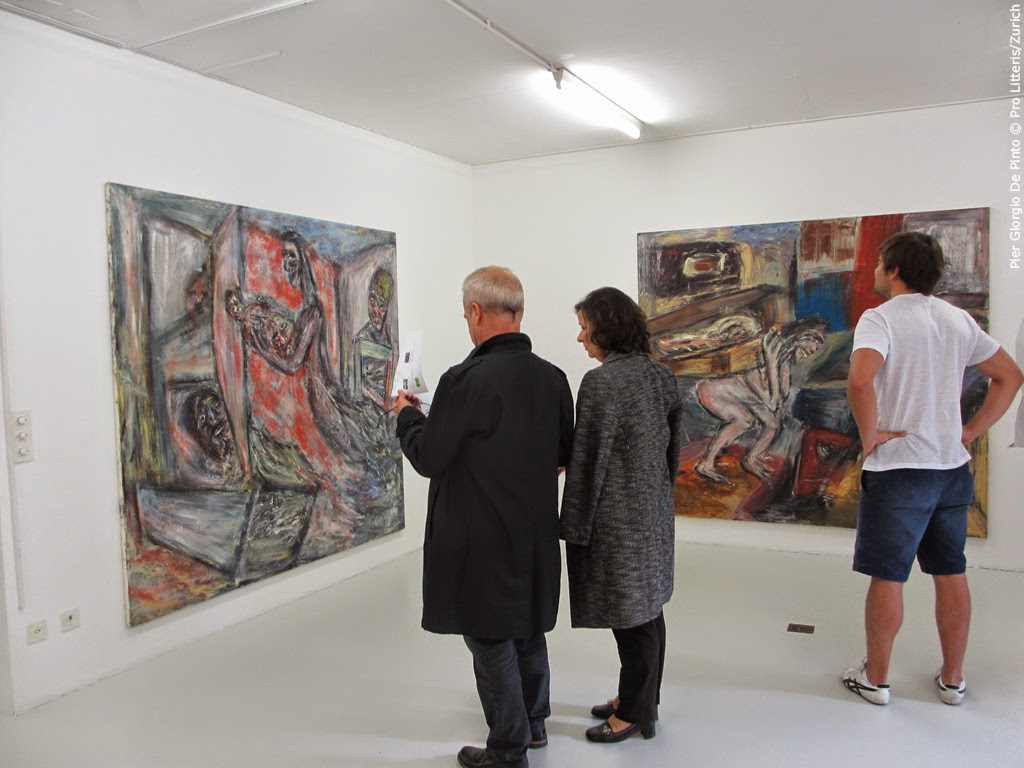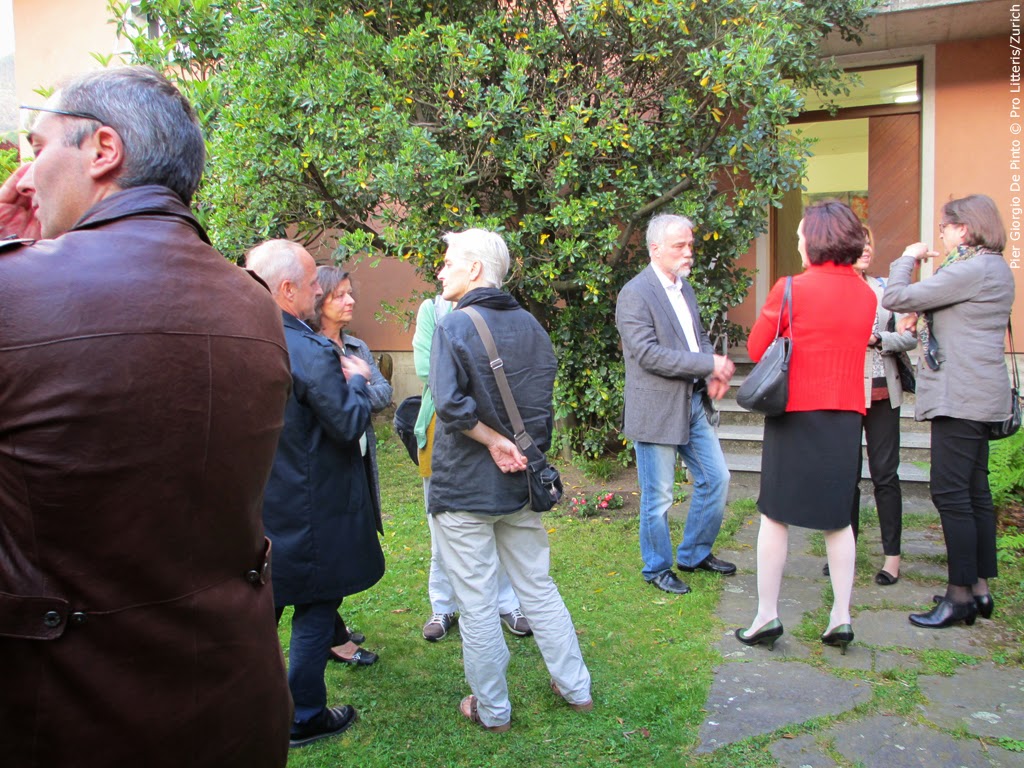METAMORPHOSIS AND
THE ARCHETYPE EXPRESSED
Martin Disler
Vernissage__Saturday
26 April 2014 from 5.30 p.m.
26 April – 6 July 2014
Fri-Sat-Sun, 2.00 –
6.00 p.m.
 |
| Martin Disler (1949-1996), Verleihung der Narrenkappe, 1995. Martin Disler Estate.Copyright Irene Grundel, Grenaa (DK). Ph SIK-ISEA, Zürich. |
On 24 September
1994, the official opening of MACT/CACT Contemporary Art in Canton Ticino coincided
with the first personal show held by Martin Disler (1949-1996) in Ticino,
curated by Mario Casanova. The exhibition featured mural paintings housed in
our own premises and a series of bronze sculptures entitled Häutung und Tanz (Skinning and
Dance, 1990-1991), in the appreciable setting designed by the architect Aurelio
Galfetti in Castelgrande.
This exhibition
marked the début of a permanent presence in Ticino for a different approach to
contemporary art, capable of connecting in particular to the rest of
Switzerland and indeed the rest of the world.
Twenty years after
that milestone event, it was almost incumbent on us to organise another
personal show in close partnership with the Martin Disler Estate: not so much a
commercially-slanted retrospective as an exhibition that reopens the discussion
about the work of this artist whose death was so untimely.
Martin Disler, whose
career spanned the period from the late seventies to the mid-nineties, constituted
a voice from Switzerland on the international art scene, a vital presence when
it came to reviving painting styles based on an analytical-expressionist matrix.
Working at the same time as the Italian phenomenon of the Transavanguardia and Germany’s Neue
Wilden, Martin Disler was always one of the most eclectic, yet original,
personalities on the scene, not so much because of his style, which was
reminiscent of the CO.BR.A movement
and the whole Brut tradition, as for
his ability to combine the finished language of painting with the endless
depths of Nordic culture and his personal existential experience. Hence Disler’s
need to experiment and to question the forms of painting repeatedly, along with
other issues, such as writing.
Self-taught, Disler
based his learning on his experience with life, which was rooted in the obscure
psychological consequences of a century, the twentieth, that had been devastated
by political ideologies, by two world wars, by psychoanalysis and by the
ruthless dictatorship of money. As a result, he prioritised the human being and
all his contradictions in his studies. Disler analysed man from a great many
standpoints – historical, anthropological and analytical – verging on a few
intense issues, balanced on a knife-edge between the refined culture of sentiments
and a society based on passions, between love and war, between man’s essence,
his survival and his vanities. Rather like in a case of automatic writing,
Disler’s painting follows his thinking and his total involvement; it is totalitarian
in the means of his strong and in some ways bulky presence: man, woman, Eros and
Thanatos, plus the third one, when three is a crowd, in this case representing
infinity and instability of affections and existence.
On this layering of
psychological perceptions, where the body can only be a mean emanation and at
the same time a scion, Martin Disler drew and painted all his troubled
existence, something of a prison among archetypes, from which he was trying to
escape, the better to find a free vision going “beyond the possible”. His
bodies, poised in a fragile equilibrium between human sentiment and animal torment,
are psycho-geographies, magmatic morphologies that verge on becoming carnal
symbols, yet unisexual in their fusion, a fusion both reciprocal and with the world:
something of a revisitation of the aesthetics of the three dimensions.
This exhibition
focuses exclusively on large-format paintings executed in 1994 and 1995 – so
after Disler’s first exhibition in Bellinzona – and two works dated 1992, placed
in a narrative in which the dramatic impact of their scale and the existential
issues dear to the artist’s heart trace something of a Via Dolorosa of the
human condition and its inexorable irreversibility.
One documentary film will also be screened during the
exhibition for didactic purposes.
Mario Casanova, 2014 [translation Pete
Kercher]
MACT/CACT Suisse enjoys the financial and cultural support of Republic
and Canton of Ticino/Swisslos, MIGROS percento culturale, Alfred Richterich
Stiftung Kastanienbaum, Friends of MACT/CACT, City of Bellinzona, the Artists.
Special thank goes
to Irene Grundel of the Martin Disler Estate who made this exhibition possible by
kindly lending its works, to Galerie Buchmann Agra/Lugano and to RSI Radiotelevisione svizzera.
 |
| Martin Disler (1949-1996), Lighthouse, 1994. Martin Disler Estate.Copyright Irene Grundel, Grenaa (DK). Ph SIK-ISEA, Zürich. |
METAMORFOSI E L’ESPRESSIONE DELL’ARCHETIPO
Martin Disler
Vernissage sabato 26 aprile 2014 dalle 17:30
26 aprile – 6 luglio 2014
Ve-sa-do dalle 14:00 alle 18:00
Il 24 settembre 1994 l’apertura ufficiale del
MACT/CACT Arte Contemporanea Ticino coincideva con la prima mostra personale di
Martin Disler (1949-1996) in Ticino a cura di Mario Casanova. La mostra
si articolava nelle nostre sale, con pitture murali, e a Castelgrande – grazie
al pregevole allestimento dell’architetto Aurelio Galfetti – con la serie di
sculture di bronzo titolata Häutung und Tanz (1990-1991).
Questa mostra segnava l’inizio della presenza
in Ticino di un approccio diverso all’arte contemporanea, capace di connettersi
in modo particolare con il resto della Svizzera e con l’Estero.
Dopo 20 anni dalla realizzazione di questo
importante evento, è parso quasi doveroso riproporre una sua personale in
stretta collaborazione con il Nachlass Martin Disler (Martin Disler Estate): non
già una retrospettiva dal taglio commemorativo, quanto piuttosto presentare
un’esposizione che rimettesse sul piano della discussione l’opera dell’artista
prematuramente scomparso.
Martin Disler, attivo soprattutto dalla fine
degli anni Settanta fino a metà degli anni Novanta, ha rappresentato per la Svizzera,
e all’interno del panorama artistico internazionale, una presenza fondamentale
per quanto attiene alla ripresa degli stilemi pittorici di matrice analitico-espressionista.
Parallelamente al fenomeno italiano della Transavanguardia
e a quello tedesco dei Neue Wilden,
Martin Disler rimane una delle personalità più eclettiche ma originali, non
tanto per uno stile che ricorda il movimento CO.BR.A e tutto il filone della tradizione Brut, quanto per la sua capacità di fondere il linguaggio pittorico
finito con le profondità infinite della cultura nordica e della sua personale esperienza
esistenziale. Da qui l’esigenza di Disler di sperimentare e rimettere in
discussione le forme della pittura, quanto altri aspetti come la scrittura.
Autodidatta, Disler si forma con le esperienze
di vita, che fondano le proprie radici nei risvolti psicologici e oscuri di un
Novecento devastato dalle ideologie politiche, da due guerre mondiali, dalla
psicoanalisi e dalla dittatura del denaro. L’essere umano e tutte le sue contraddizioni
rimangono, quindi, prioritarie all’interno del suo studio; Disler analizza l’uomo
da molteplici punti di vista; da quello storico, antropologico, analitico,
andando a toccare pochi temi ma intensi, in bilico tra la cultura del
sentimento e la società delle passioni, tra amore e guerra, tra l’essenza
dell’uomo, la sua sopravvivenza e le sue vanità. Come in una scrittura
automatica, la pittura di Disler segue il suo pensiero e il suo coinvolgimento
totale; e totalitario nel verso della sua presenza forte e per taluni aspetti
ingombrante: l’uomo, la donna, Eros e Thanatos, e il terzo, questo incomodo che
rappresenta infinità e instabilità affettiva ed esistenziale.
Su questa stratificazione delle percezioni
psicologiche, ove il corpo non può esserne che una vile emanazione e nel
contempo talea, Martin Disler disegna e dipinge tutta la sua irrequieta esistenza,
una sorta di prigione tra gli archetipi, da cui fugge per ritrovare una libera visione
‘oltre il possibile’. I suoi corpi, in equilibrio fragile tra il sentimento
umano e il tormento animale, sono delle psico-geografie, morfologie magmatiche
che diventano quasi simboli carnali ma unisessuati nella fusione reciproca e
con il mondo; una sorta di rivisitazione dell’estetica della tri-dimensionalità.
In mostra vengono presentate esclusivamente opere
pittoriche di grande formato eseguite negli anni 1994 e 1995 – e successivi
alla prima mostra di Bellinzona –, e due opere del 1992, all’interno di un
percorso narrativo, dove la drammaticità della dimensione e i temi esistenziali
cari all’autore ridisegnano una sorta di Via Crucis della condizione umana e della
sua inesorabile irreversibilità.
A titolo didattico, verrà presentato al pubblico un documento filmico storico.
Mario Casanova, 2014
MACT/CACT Arte Contemporanea Ticino è sostenuto
finanziariamente e culturalmente da Repubblica e Cantone del Ticino/Swisslos,
MIGROS percento culturale, Alfred Richterich Stiftung Kastanienbaum, Amici del
MACT/CACT, Città di Bellinzona, gli Artisti.
Un ringraziamento molto particolare va a Irene
Grundel del Nachlass Martin Disler per aver gentilmente concesso il prestito
delle opere, alla Galleria Buchmann Agra/Lugano e a RSI Radiotelevisione svizzera.


























